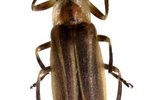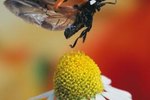They look like hummingbirds, hover in midair like hummingbirds, hum like hummingbirds and drink nectar from the same flowers -- yet hummingbirds and the extraordinary moths that mimic them aren't remotely related. Hummingbird moths range throughout North America, but spotting this masterpiece of Mother Nature is a rare treat. If you'd like to increase the odds, make sure their favorite food sources are well represented in your garden and keep your eyes peeled during the times of day they're most likely to appear.
A Bird or a Bug?
One thing that makes these little critters so challenging to spot is that, when people see them, they don't realize what they're looking at. Even when you're peering at them up close, they can fool you. Know what to look for to recognize this elusive master of disguise, Hemaris thysbe. A ruby-throated hummingbird is about 3 inches long; a hummingbird moth is about half that. Like a hummingbird, the moth's body is spindle-shaped, plump in the middle and narrower at the ends -- but if you spot antennae, it's definitely a moth. A male usually has a tuft on his posterior resembling the flared tail feathers of a hovering hummingbird. Typical coloration is olive-green with a wide reddish-brown band. When he's hovering near a flower, the moth's wings beat so fast they are almost invisible and, like a hummingbird's, they emit a slight buzzing sound. The difference is that a moth's wings are transparent. The moth's long proboscis looks like a beak, but when it's not in use it gets furled up and is therefore unseen.
Early Life
The female hummingbird moth often lays only one egg at a time, or very few, on a few favorite host plants or the undersides of fallen leaves. The caterpillar that hatches from these eggs, yellowish-green with reddish spots on hos sides, green lines and a protrusion on his back end resembling a horn, is a fat, tasty treat for many kinds of birds. If the caterpillar lives long enough, he eventually climbs down the plant to the ground and wraps himself up in a cocoon. This is called the pupa, or resting, stage of development. If this occurs early in the season, an adult moth will emerge in a few weeks, but if it doesn't take place until fall, the adult won't emerge until the next spring.
Habits
According to the U.S. Forest Service, four species of hummingbird moth exist in North America but the two main ones are the snowberry clearwing, more common in the West, and the hummingbird clearwing, more common in the East. Unlike most moths, the hummers are most active during daytime hours or close to dusk. If you spot one in your garden, take note of the time -- because if it comes back another day, it'll probably be around the same time. In most regions, these tiny wonders are welcome visitors to any garden; but if they overpopulate, as they sometimes do in Colorado, they may become pests.
Attracting Hummingbird Moths
Hummingbird moths have a special fondness for plants in the honeysuckle family, including snowberry and viburnum. They gravitate to phlox, beebalm, dogbane, verbena and buddleia, also known as butterfly bush. Even though they start flying in spring, you're most likely to see them between June and August, when their favorite flowers are churning out the most nectar. The timing of this process will vary from one plant to the next -- but if bees and butterflies seem to be taking a great interest in a certain type of plant, chances are it will hold the same appeal for hummingbird moths.
References
- The Garden of Eaden: How to Attract the Hummingbird Hawk Moth
- Mass Audubon: Hummingbird Moth
- Pestnet: Hummingbird Moth
- Butterflies and Moths of North America: FAQ
- U.S. Forest Service: Hummingbird Moth
- Native Plant Wildlife Gardens: I’ve Just Seen a Baby Hummingbird ... NOT !
- Fairfax County Public Schools: Hummingbird Moths





